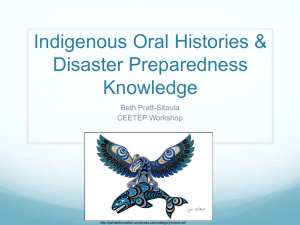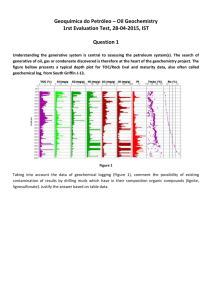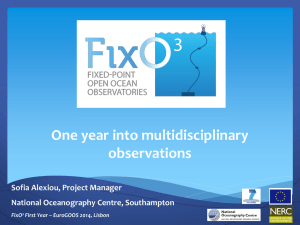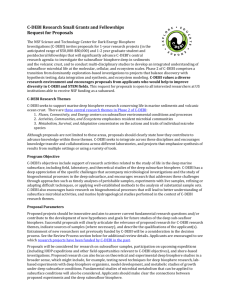Clearance_Charts
advertisement
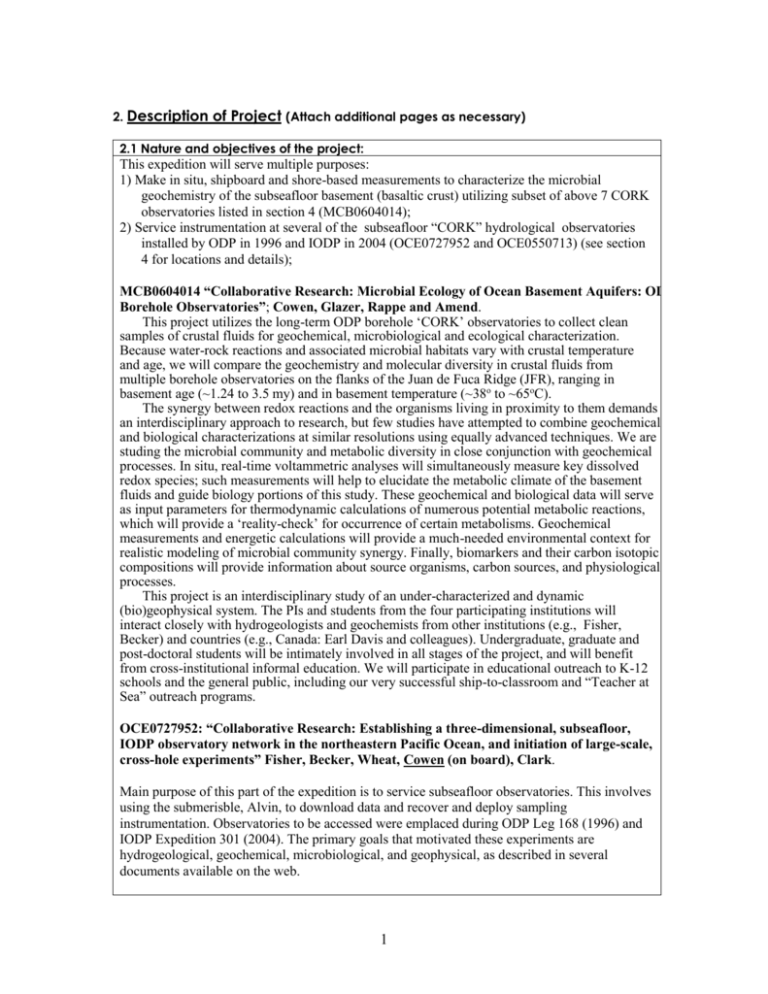
2. Description of Project (Attach additional pages as necessary) 2.1 Nature and objectives of the project: This expedition will serve multiple purposes: 1) Make in situ, shipboard and shore-based measurements to characterize the microbial geochemistry of the subseafloor basement (basaltic crust) utilizing subset of above 7 CORK observatories listed in section 4 (MCB0604014); 2) Service instrumentation at several of the subseafloor “CORK” hydrological observatories installed by ODP in 1996 and IODP in 2004 (OCE0727952 and OCE0550713) (see section 4 for locations and details); MCB0604014 “Collaborative Research: Microbial Ecology of Ocean Basement Aquifers: ODP Borehole Observatories”; Cowen, Glazer, Rappe and Amend. This project utilizes the long-term ODP borehole ‘CORK’ observatories to collect clean samples of crustal fluids for geochemical, microbiological and ecological characterization. Because water-rock reactions and associated microbial habitats vary with crustal temperature and age, we will compare the geochemistry and molecular diversity in crustal fluids from multiple borehole observatories on the flanks of the Juan de Fuca Ridge (JFR), ranging in basement age (~1.24 to 3.5 my) and in basement temperature (~38o to ~65oC). The synergy between redox reactions and the organisms living in proximity to them demands an interdisciplinary approach to research, but few studies have attempted to combine geochemical and biological characterizations at similar resolutions using equally advanced techniques. We are studing the microbial community and metabolic diversity in close conjunction with geochemical processes. In situ, real-time voltammetric analyses will simultaneously measure key dissolved redox species; such measurements will help to elucidate the metabolic climate of the basement fluids and guide biology portions of this study. These geochemical and biological data will serve as input parameters for thermodynamic calculations of numerous potential metabolic reactions, which will provide a ‘reality-check’ for occurrence of certain metabolisms. Geochemical measurements and energetic calculations will provide a much-needed environmental context for realistic modeling of microbial community synergy. Finally, biomarkers and their carbon isotopic compositions will provide information about source organisms, carbon sources, and physiological processes. This project is an interdisciplinary study of an under-characterized and dynamic (bio)geophysical system. The PIs and students from the four participating institutions will interact closely with hydrogeologists and geochemists from other institutions (e.g., Fisher, Becker) and countries (e.g., Canada: Earl Davis and colleagues). Undergraduate, graduate and post-doctoral students will be intimately involved in all stages of the project, and will benefit from cross-institutional informal education. We will participate in educational outreach to K-12 schools and the general public, including our very successful ship-to-classroom and “Teacher at Sea” outreach programs. OCE0727952: “Collaborative Research: Establishing a three-dimensional, subseafloor, IODP observatory network in the northeastern Pacific Ocean, and initiation of large-scale, cross-hole experiments” Fisher, Becker, Wheat, Cowen (on board), Clark. Main purpose of this part of the expedition is to service subseafloor observatories. This involves using the submerisble, Alvin, to download data and recover and deploy sampling instrumentation. Observatories to be accessed were emplaced during ODP Leg 168 (1996) and IODP Expedition 301 (2004). The primary goals that motivated these experiments are hydrogeological, geochemical, microbiological, and geophysical, as described in several documents available on the web. 1 ODP Leg 168 summary: http://www-odp.tamu.edu/publications/168_IR/01_CHAP.PDF IODP Expedition 301 summary: http://publications.iodp.org/proceedings/301/101/101_.htm Subseafloor observatory description and discussion of experimental goals: http://publications.iodp.org/proceedings/301/EXP_REPT/CHAPTERS/301_103.PDF Expeditions to service these observatories have occurred using the ROV, ROPOS, or the submersible, Alvin, in every year since 2004 when three Expedition 301 observatories were deployed at Sites 1026 and 1301. The Summer 2009 program is the last of this initial set of servicing expeditions, intended to prepare the existing observatories for future drilling (which will emplace three more observatories and conduct hydrologic experiments), and to be followed by additional experimental dive work on these installations. The two observatories at Site 1301 were not fully sealed when they were deployed in 2004, and the drilling vessel, J. Resolution, will visit the two observatories at Site 1301 in early Summer 2009, prior to this Atlantis/Alvin expedition, with the intent of sealing these systems by pumping cement into the reentry cones surrounding the well heads. One goal of the Summer 2009 dive program is to assess the success of these sealing operations. We will also recover seafloor and downhole fluid and microbiological sampling and substrate systems, and replace these with new systems capable of collecting samples for the next 4-5 years. We originally planned to service additional observatories at sites to the west, but this last work was deferred to 2010 because of a spatial and temporal conflict with Endeavor Ridge work that will occur at the same time. 3.3 Particulars of methods and scientific instruments Types of samples and data Multibeam Borehole fluid samples Methods to be used Installation/recovery of various samplers on/from CORK (wellhead) valves via ALVIN Long-term subseafloor pressure records Serial communication to computer via Alvin Potential water column samples Temperature, redox, Eh, Oxygen, pH measurements of borehole fluids, gases Bathymetry Sampling on wireline Sensor associated with ALVIN-carried instruments (MPU) or independent sleds Instruments to be used Seabeam Mobile Pump Unit; Large Volume Bag Samplers; GeoMICROBE instrument sled; Ti-majors, gas-tights, syringe samplers; Osmosamplers Gauges and data logging systems at wellheads Prototype water column samplers/analyzers, CTD Sensor arrays 3.5 kHz 12 kHz 75 kHz 150 kHz ADCP 2 3.4 Indicate whether harmful substances will be used: Radioisotopes (S-35, C-14, H-3) will be used on board (radioisotope van) 3.5 Indicate whether drilling will be carried out: No 3.6 Indicate whether explosives will be used: No 4. Installations and Equipment Details of installations and equipment (dates of laying, servicing, recovery; exact locations and depth): 1. Hole 1026B, Cascadia Basin, 47°45.759’N 127°45.552’W, 2658 m, installed 1996/2004 (Leg 301) 2. Hole 1027C, Cascadia Basin, 47°45.387’N 127°43.867’W, 2656 m, installed 1996 (Leg 301) 3. Hole 1301A, Cascadia Basin, 47°45.209’N 127°45.833’ W, 2658 m, installed 2004 (Leg 301) 4. Hole 1301B, Cascadia Basin, 47°45.229’N 127°45.826’W, 2658 m, installed 2004 (Leg 301) 5. Hole 1024C, Cascadia Basin 47o 54.531’N 128o 45.005’W, 2612 m, installed 1996 (Leg 168) 6. Hole 1025C, Cascadia Basin 47o 53.247’N 128o 38.919’W, 2606 m, installed 1996 (Leg 168) 7. Hole 857D, Middle Valley 48o 26.517’N 128o 42.651’W, 2432 m, installed 1991/1996 (Legs 139/169) 5. Geographical Areas 5.1 Indicate geographical areas in which the project is to be conducted (with reference in latitude and longitude): Primary Work Site: Cascadia Basin (Eastern flank of Juan de Fuca Ridge) and Northern Juan de Fuca Ridge (Middle Valley): 47o 40’ to 48o 30’ N lat., 127o 40’ to 128o 45’ W long. Secondary Study site (night time water column operations only): Endeavour Segment—10 nm radius around 47o 57’ N, 129o 06’ W. 5.2 Attach chart(s) at an appropriate scale (1 page, high-resolution) showing the geographical areas of the intended work and, as far as practicable, the positions of intended stations, the tracks of survey lines, and the locations of installations and equipment. Figure 1. General map of Juan de Fuca Ridge and Cascadia Basin showing all work sites, and primary ship track from San Francisco to Work Sites to Astoria Port. Figure 2. Close up Primary work sites (CORK boreholes). Figure 3. Close up of Middle Valley with Work Site 857D. Figure 4. Bathymetry for Secondary Work Site (night ops, water column only) of Endeavour Segment. Figure 5. Close up of Endeavour showing main hydrothermal vent fields. 3 Figure 1. Juan de Fuca Ridge and Cascadia Basin map, showing general location of work sites (borehole CORKs 857C, 1024C, 1025C, 1026B, 1027C, 1301A, and 1301B, plus secondary night op station Main Hydrothermal Field, Endeavour Segment). Figure 2. Close up of primary dive sites (CORKs 857D, 1024C, 1025C, 1026B, 1027C, 1301A, 1301B). 4 Figure 3. Bathymetery of Midddle Valley (from Davis and Villinger, 1992). Shows position of Borehole CORK 857 with respect to known vent sites (e.g., Dead Dog, Bent Hill). Contours drawn at 10 m intervals. Modified from Mottl, Davis, Fisher and Slack (Eds), 1994. 5 Figure 4. EM300 map of the Endeavour Segment. 6 Figure 5. Close up of Endeavour Segment showing five known hydrothermal fields. 7 6. Dates 6.1 Expected dates of first entry into and final departure from the research area of the research vessel: 15 June 2010 to 30 June 2010 6.2 Indicate if multiple entry is expected: Not anticipated, unless presently unanticipated conflict arises with another research ship. 7. Port Calls 7.1 Dates and names of intended ports of call in Depart San Francisco, CA 13 June 2010 Arrive Astoria, OR 1 July 2010 7.2 Any special logistical requirements at ports of call: None 7.3 Name/Address/Telephone of shipping agent (if available): San Francisco, CA: Vasile Tudoran Transport 819 Ohio Ave. Long Beach, CA 90804 Contact: Vasile Tudoran Phone: (562) 882-5590 Fax: (562) 434-9800 Email: vtudoran@aol.com Astoria, OR: Ship Service Co. 968 Commercial St. Astoria, OR 97103 Contact: Lou Marconeri Phone: (503) 325-3721 Fax: (503) 325-4109 Cell: (503) 791-0796 Email: lmarconeri@knutsenins.com Email (weekends only): cmarconeri@charter.net 8. Participation: 8.1 Extent to which coastal state will be enabled to participate or to be represented in the research project: Accommodations will be made for observers from the coastal state. Active project collaborators includes researchers from the Pacific Geoscience Center, Geological Survey of Canada, Dr. Earl Davis. Berths are being held for Davis or his designate. 8.2 Proposed dates and ports for embarkation/disembarkation: 8 Embark San Francisco, CA 13 June 2010 Disembark Astoria, OR 1 July 2010 9. Access to data, samples and research results 9.1 Expected dates of submission to coastal state of preliminary reports, which should include the expected dates of submission of the final results: No more than 30 days from the end date of the cruise. 9.2 Proposed means for access by coastal state to data and samples: Samples collected will be described and inventoried in a cruise report. Alvin dive logs will be included on a cruise CD. Video and still imagery will be described in the cruise report and made available to interested parties upon request. Full, immediate access to subseafloor pressure data via Dr. Earl Davis, GSC. 9.3 Proposed means to provide coastal state with assessment of data, samples and research results or provide assistance in their assessment or interpretation: Sample quality and quantity, and designated contact person, will be described in the cruise report. All sampling areas will be documented by video prior and subsequent to collection. 9.4 Proposed means of making results internationally available: The cruise report will be submitted to the US State department. Follow-up on analyses will be published in a timely manner in internationally recognized journals. Subseafloor pressure data will be made available through IODP, following reformatting by PGC personnel. 9
